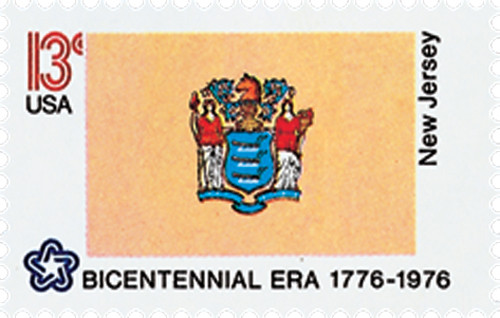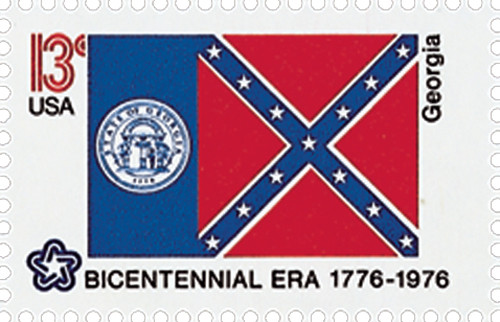
# 1670 - 1976 13c State Flags: Colorado
U.S. 1670
1976 Colorado
State Flags
American Bicentennial Series
• First time a sheet 50 had all different stamp designs
• Part of the American Bicentennial Series
Stamp Category: Commemorative
Series: American Bicentennial Series
Value: 13¢ First-class postage rate
First Day of Issue: February 23, 1976
First Day City(s): Washington, DC
Quantity Issued: 8,720,100 (panes of 50)
Printed by: Bureau of Engraving and Printing
Printing Method: Photogravure
Format: Sheet of 50
Perforations: 11
Why the stamp was issued:
The United States Postal Service celebrated the American Bicentennial with a full pane of the Union’s fifty state flags.
About the stamp design:
The state flag of Colorado was designed by Andrew Carlisle Carson. Officially adopted on June 5, 1911, the Colorado State Flag utilizes elegant simplicity to evoke a number of significant meanings. The field consists of three stripes, two blue and one white. The blue is meant to symbolize Colorado's clear blue skies as well as the state flower, the columbine. The white stripe across the middle is said to represent the state's famous snow-capped mountains, while the red of the C (which stands for Colorado) reflects the color of most of the state's soil. The gold disc in the center of the C is meant to signify the state's history in gold mining and ample sunshine.
About the printing process:
Printed by the Bureau of Engraving and Printing on their seven-color Andreotti gravure press (601) which was their work horse for multicolored stamps.
About the American Bicentennial Series:
In the 1970s, America celebrated its 200th anniversary with hundreds of national events commemorating the heroes and historic events that led to our nation’s independence from Great Britain. The U.S. Postal Service issued 113 commemorative stamps over a six-year period in honor of the U.S. bicentennial, beginning with the American Revolution Bicentennial Commission Emblem stamp (U.S. #1432). As a group, the Bicentennial Series chronicles one of our nation’s most important chapters, and remembers the events and patriots who made the U.S. a world model for liberty.
Several of the stamps honored colonial life – craftsmen and communication. Other stamps honored important battles including Lexington and Concord, Bunker Hill, and Saratoga. Significant events such as the Boston Tea Party, the meeting of the First Continental Congress, and the Declaration of Independence were featured as well. The stamps also honored many significant people such as George Washington, Sybil Ludington, Salem Poor, and the Marquis de Lafayette.
Many of the stamps feature classic artwork. For instance, the set of four souvenir sheets picture important events recreated by noted artists such as John Trumbull. The Bicentennial Series also includes an important US postal first – the first 50-stamp se-tenant – featuring all 50 state flags. The format proved to be popular with collectors, and has been repeated many times since.
The American Bicentennial Series is packed with important US history – it tells the story of our nation’s fight for independence through stamps.
History the stamp represents:
On August 1, 1876, President Ulysses S. Grant signed legislation admitting Colorado to the Union as the Centennial State (it was admitted 28 days after the 100th anniversary of the United States).
When Spanish explorers first visited the region that is now Colorado in the 1600s, they found several different Indian groups already inhabited it. The Arapaho, Cheyenne, Comanche, Kiowa, and Pawnee tribes lived on the vast plains and the Utes lived in the mountain valleys. Failing to find gold, the Spaniards left without attempting to colonize the area. In 1682, French explorer Robert Cavelier, Sieur de la Salle, claimed an area that included present-day eastern Colorado. In 1706, Juan de Ulibarri claimed the region for Spain.
The United States acquired the region that is now eastern and central Colorado as part of the Louisiana Purchase, in 1803. Teams led by Zebulon M. Pike and Major Stephen H. Long explored the area. In 1833, the first permanent American settlement was established at Bent’s Fort, near present-day La Junta. The fort was used as a base for several famous frontiersmen of the time. In 1821, Mexico gained control of western Colorado from Spain. The region came under United States control twenty-seven years later, under the terms of the treaty that ended the Mexican-American War.
Colorado was sparsely populated until 1858, when prospectors found gold along Cherry Creek. Word spread quickly as gold hunters flocked to the area. By the following year, more than 100,000 people had come to Colorado in search of riches. However, more than half turned back, disappointed that they had not found much gold.
As the population grew in the Colorado area, government became an important issue. Settlers created the Jefferson Territory, ignoring Indian claims that they were given the land by various treaties. In 1861, Congress, which until that point had not recognized the Jefferson Territory, established the Colorado Territory with William Gilpin as the first governor.
The 1860s and 1870s were scarred by violent clashes between Colorado’s new settlers and the Indians native to the region. In 1864, nearly 300 Cheyenne Indians were killed by a group of Colorado militia. Critical of the attack, the U.S. government paid reparations to the Indians. Four years later, a group of Indians attacked a group of army scouts on the Arikaree River. The army scouts fought the Indians for several days, until they were rescued by additional troops.
Tensions between the Indians and whites finally came to an end in 1879, following the Meeker Massacre. During the massacre, a group of Ute Indians killed their reservation agent and ambushed a body of troops. In the aftermath, Ouray, a respected Ute chief, helped the Indians settle their differences with the white men once and for all.
In 1875, Congress passed an enabling act outlining the requirements for the Territory of Colorado to become a state. Colorado became the 38th state of the Union on August 1, 1876. John L. Routt, the former territorial governor, was elected as the first State Governor.
U.S. 1670
1976 Colorado
State Flags
American Bicentennial Series
• First time a sheet 50 had all different stamp designs
• Part of the American Bicentennial Series
Stamp Category: Commemorative
Series: American Bicentennial Series
Value: 13¢ First-class postage rate
First Day of Issue: February 23, 1976
First Day City(s): Washington, DC
Quantity Issued: 8,720,100 (panes of 50)
Printed by: Bureau of Engraving and Printing
Printing Method: Photogravure
Format: Sheet of 50
Perforations: 11
Why the stamp was issued:
The United States Postal Service celebrated the American Bicentennial with a full pane of the Union’s fifty state flags.
About the stamp design:
The state flag of Colorado was designed by Andrew Carlisle Carson. Officially adopted on June 5, 1911, the Colorado State Flag utilizes elegant simplicity to evoke a number of significant meanings. The field consists of three stripes, two blue and one white. The blue is meant to symbolize Colorado's clear blue skies as well as the state flower, the columbine. The white stripe across the middle is said to represent the state's famous snow-capped mountains, while the red of the C (which stands for Colorado) reflects the color of most of the state's soil. The gold disc in the center of the C is meant to signify the state's history in gold mining and ample sunshine.
About the printing process:
Printed by the Bureau of Engraving and Printing on their seven-color Andreotti gravure press (601) which was their work horse for multicolored stamps.
About the American Bicentennial Series:
In the 1970s, America celebrated its 200th anniversary with hundreds of national events commemorating the heroes and historic events that led to our nation’s independence from Great Britain. The U.S. Postal Service issued 113 commemorative stamps over a six-year period in honor of the U.S. bicentennial, beginning with the American Revolution Bicentennial Commission Emblem stamp (U.S. #1432). As a group, the Bicentennial Series chronicles one of our nation’s most important chapters, and remembers the events and patriots who made the U.S. a world model for liberty.
Several of the stamps honored colonial life – craftsmen and communication. Other stamps honored important battles including Lexington and Concord, Bunker Hill, and Saratoga. Significant events such as the Boston Tea Party, the meeting of the First Continental Congress, and the Declaration of Independence were featured as well. The stamps also honored many significant people such as George Washington, Sybil Ludington, Salem Poor, and the Marquis de Lafayette.
Many of the stamps feature classic artwork. For instance, the set of four souvenir sheets picture important events recreated by noted artists such as John Trumbull. The Bicentennial Series also includes an important US postal first – the first 50-stamp se-tenant – featuring all 50 state flags. The format proved to be popular with collectors, and has been repeated many times since.
The American Bicentennial Series is packed with important US history – it tells the story of our nation’s fight for independence through stamps.
History the stamp represents:
On August 1, 1876, President Ulysses S. Grant signed legislation admitting Colorado to the Union as the Centennial State (it was admitted 28 days after the 100th anniversary of the United States).
When Spanish explorers first visited the region that is now Colorado in the 1600s, they found several different Indian groups already inhabited it. The Arapaho, Cheyenne, Comanche, Kiowa, and Pawnee tribes lived on the vast plains and the Utes lived in the mountain valleys. Failing to find gold, the Spaniards left without attempting to colonize the area. In 1682, French explorer Robert Cavelier, Sieur de la Salle, claimed an area that included present-day eastern Colorado. In 1706, Juan de Ulibarri claimed the region for Spain.
The United States acquired the region that is now eastern and central Colorado as part of the Louisiana Purchase, in 1803. Teams led by Zebulon M. Pike and Major Stephen H. Long explored the area. In 1833, the first permanent American settlement was established at Bent’s Fort, near present-day La Junta. The fort was used as a base for several famous frontiersmen of the time. In 1821, Mexico gained control of western Colorado from Spain. The region came under United States control twenty-seven years later, under the terms of the treaty that ended the Mexican-American War.
Colorado was sparsely populated until 1858, when prospectors found gold along Cherry Creek. Word spread quickly as gold hunters flocked to the area. By the following year, more than 100,000 people had come to Colorado in search of riches. However, more than half turned back, disappointed that they had not found much gold.
As the population grew in the Colorado area, government became an important issue. Settlers created the Jefferson Territory, ignoring Indian claims that they were given the land by various treaties. In 1861, Congress, which until that point had not recognized the Jefferson Territory, established the Colorado Territory with William Gilpin as the first governor.
The 1860s and 1870s were scarred by violent clashes between Colorado’s new settlers and the Indians native to the region. In 1864, nearly 300 Cheyenne Indians were killed by a group of Colorado militia. Critical of the attack, the U.S. government paid reparations to the Indians. Four years later, a group of Indians attacked a group of army scouts on the Arikaree River. The army scouts fought the Indians for several days, until they were rescued by additional troops.
Tensions between the Indians and whites finally came to an end in 1879, following the Meeker Massacre. During the massacre, a group of Ute Indians killed their reservation agent and ambushed a body of troops. In the aftermath, Ouray, a respected Ute chief, helped the Indians settle their differences with the white men once and for all.
In 1875, Congress passed an enabling act outlining the requirements for the Territory of Colorado to become a state. Colorado became the 38th state of the Union on August 1, 1876. John L. Routt, the former territorial governor, was elected as the first State Governor.


















